BMP4005 - Information Systems: IT Solutions & Management Decisions
VerifiedAdded on 2023/06/14
|10
|3037
|493
Report
AI Summary
This report provides an analysis of information systems and big data, focusing on their role in supporting management decisions within organizations. It defines various theories, methods, and techniques related to the design and development of IT solutions, specifically examining McAfee and MS Office. The report also defines and provides examples of different systems such as Decision Support Systems (DSS), Executive Support Systems (ESS), Transaction Processing Systems (TPS), Management Information Systems (MIS), and Knowledge Management Systems (KMS). Furthermore, it explores the concept of globalization and the effects of IT on globalization, discusses digital infrastructure with its benefits and disadvantages, and addresses the risks associated with information systems outsourcing, highlighting the critical role of IT infrastructure in digital transformation. The analysis covers topics such as digital infrastructure, the impact of IT on globalization, and the risks of IT outsourcing.
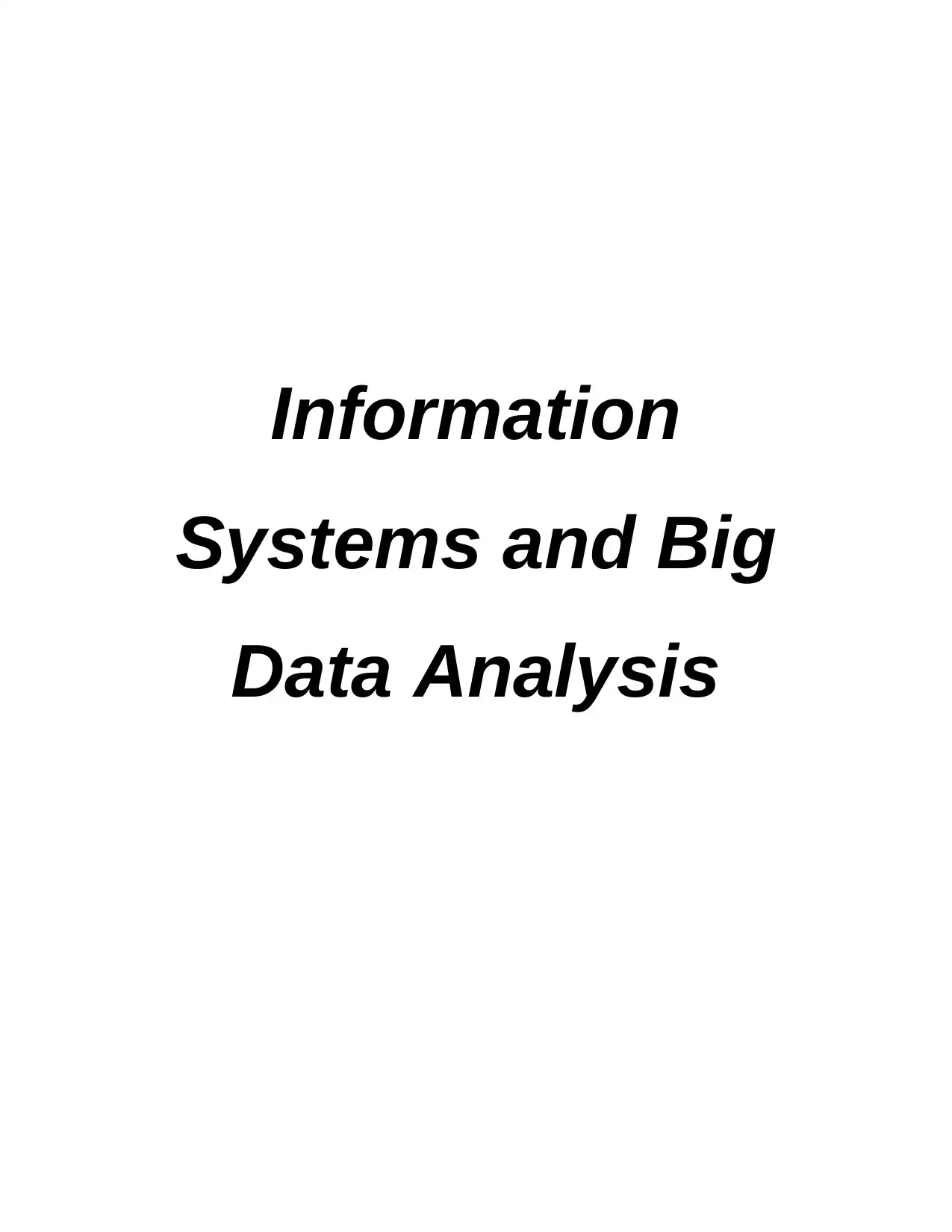
Information
Systems and Big
Data Analysis
Systems and Big
Data Analysis
Paraphrase This Document
Need a fresh take? Get an instant paraphrase of this document with our AI Paraphraser
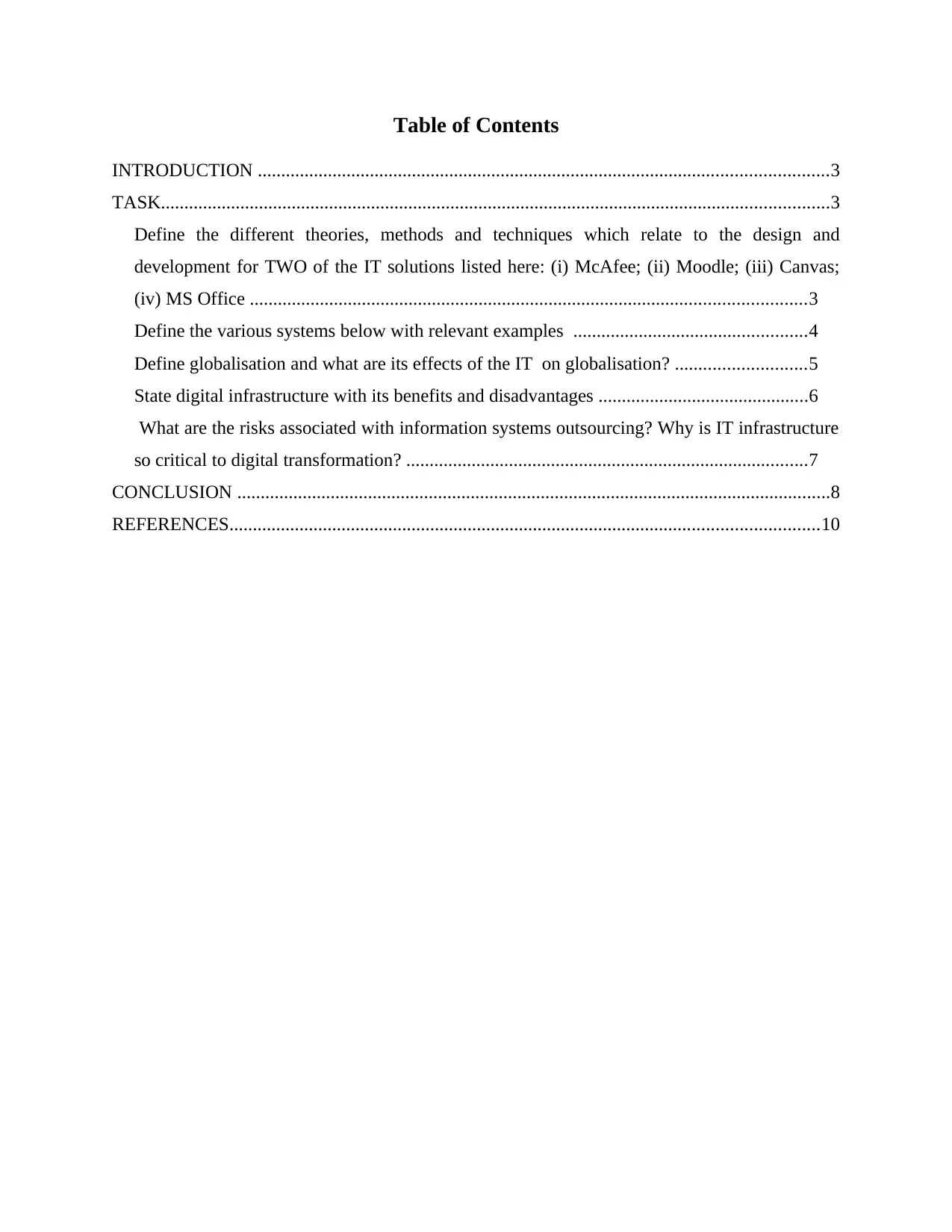
Table of Contents
INTRODUCTION ..........................................................................................................................3
TASK...............................................................................................................................................3
Define the different theories, methods and techniques which relate to the design and
development for TWO of the IT solutions listed here: (i) McAfee; (ii) Moodle; (iii) Canvas;
(iv) MS Office .......................................................................................................................3
Define the various systems below with relevant examples ..................................................4
Define globalisation and what are its effects of the IT on globalisation? ............................5
State digital infrastructure with its benefits and disadvantages .............................................6
What are the risks associated with information systems outsourcing? Why is IT infrastructure
so critical to digital transformation? ......................................................................................7
CONCLUSION ...............................................................................................................................8
REFERENCES..............................................................................................................................10
INTRODUCTION ..........................................................................................................................3
TASK...............................................................................................................................................3
Define the different theories, methods and techniques which relate to the design and
development for TWO of the IT solutions listed here: (i) McAfee; (ii) Moodle; (iii) Canvas;
(iv) MS Office .......................................................................................................................3
Define the various systems below with relevant examples ..................................................4
Define globalisation and what are its effects of the IT on globalisation? ............................5
State digital infrastructure with its benefits and disadvantages .............................................6
What are the risks associated with information systems outsourcing? Why is IT infrastructure
so critical to digital transformation? ......................................................................................7
CONCLUSION ...............................................................................................................................8
REFERENCES..............................................................................................................................10
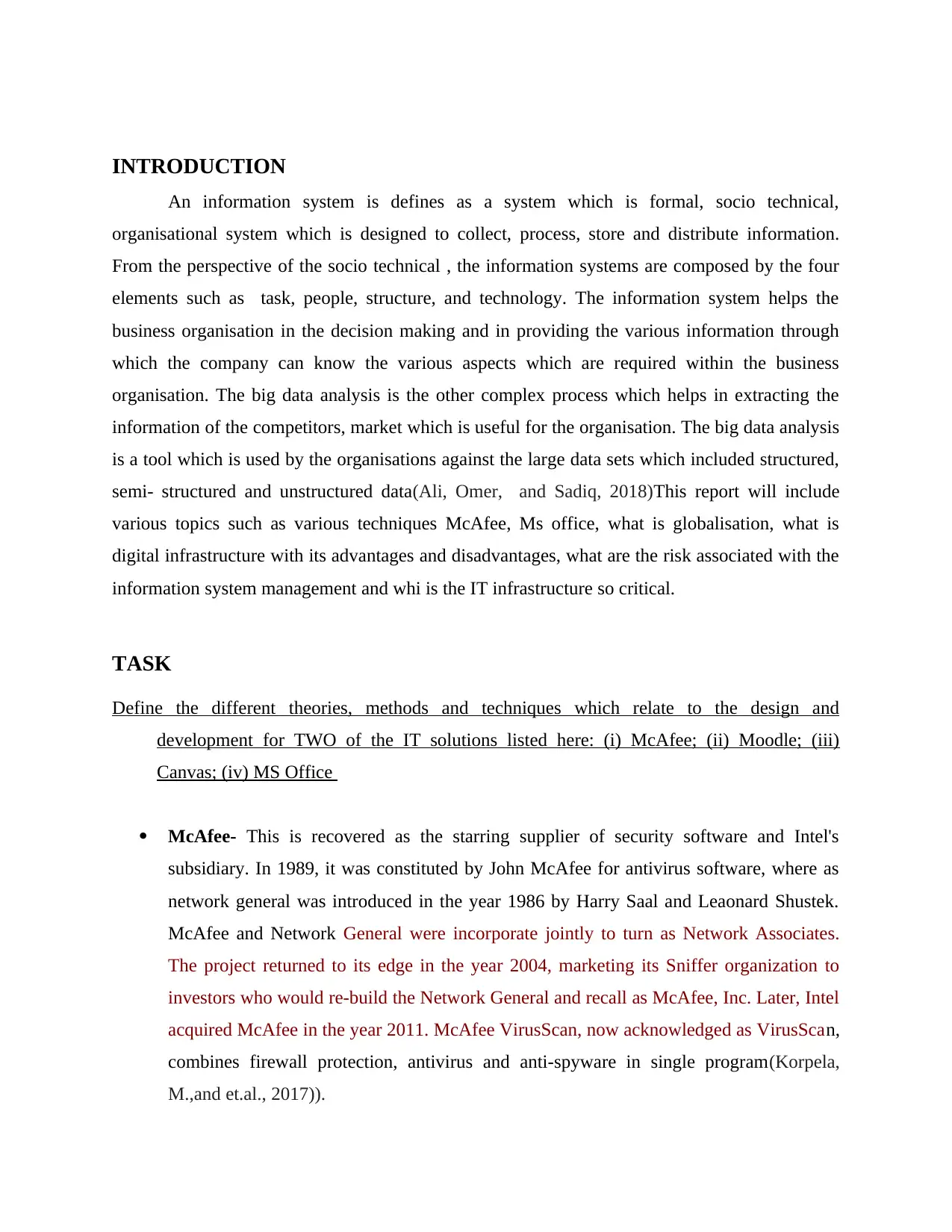
INTRODUCTION
An information system is defines as a system which is formal, socio technical,
organisational system which is designed to collect, process, store and distribute information.
From the perspective of the socio technical , the information systems are composed by the four
elements such as task, people, structure, and technology. The information system helps the
business organisation in the decision making and in providing the various information through
which the company can know the various aspects which are required within the business
organisation. The big data analysis is the other complex process which helps in extracting the
information of the competitors, market which is useful for the organisation. The big data analysis
is a tool which is used by the organisations against the large data sets which included structured,
semi- structured and unstructured data(Ali, Omer, and Sadiq, 2018)This report will include
various topics such as various techniques McAfee, Ms office, what is globalisation, what is
digital infrastructure with its advantages and disadvantages, what are the risk associated with the
information system management and whi is the IT infrastructure so critical.
TASK
Define the different theories, methods and techniques which relate to the design and
development for TWO of the IT solutions listed here: (i) McAfee; (ii) Moodle; (iii)
Canvas; (iv) MS Office
McAfee- This is recovered as the starring supplier of security software and Intel's
subsidiary. In 1989, it was constituted by John McAfee for antivirus software, where as
network general was introduced in the year 1986 by Harry Saal and Leaonard Shustek.
McAfee and Network General were incorporate jointly to turn as Network Associates.
The project returned to its edge in the year 2004, marketing its Sniffer organization to
investors who would re-build the Network General and recall as McAfee, Inc. Later, Intel
acquired McAfee in the year 2011. McAfee VirusScan, now acknowledged as VirusScan,
combines firewall protection, antivirus and anti-spyware in single program(Korpela,
M.,and et.al., 2017)).
An information system is defines as a system which is formal, socio technical,
organisational system which is designed to collect, process, store and distribute information.
From the perspective of the socio technical , the information systems are composed by the four
elements such as task, people, structure, and technology. The information system helps the
business organisation in the decision making and in providing the various information through
which the company can know the various aspects which are required within the business
organisation. The big data analysis is the other complex process which helps in extracting the
information of the competitors, market which is useful for the organisation. The big data analysis
is a tool which is used by the organisations against the large data sets which included structured,
semi- structured and unstructured data(Ali, Omer, and Sadiq, 2018)This report will include
various topics such as various techniques McAfee, Ms office, what is globalisation, what is
digital infrastructure with its advantages and disadvantages, what are the risk associated with the
information system management and whi is the IT infrastructure so critical.
TASK
Define the different theories, methods and techniques which relate to the design and
development for TWO of the IT solutions listed here: (i) McAfee; (ii) Moodle; (iii)
Canvas; (iv) MS Office
McAfee- This is recovered as the starring supplier of security software and Intel's
subsidiary. In 1989, it was constituted by John McAfee for antivirus software, where as
network general was introduced in the year 1986 by Harry Saal and Leaonard Shustek.
McAfee and Network General were incorporate jointly to turn as Network Associates.
The project returned to its edge in the year 2004, marketing its Sniffer organization to
investors who would re-build the Network General and recall as McAfee, Inc. Later, Intel
acquired McAfee in the year 2011. McAfee VirusScan, now acknowledged as VirusScan,
combines firewall protection, antivirus and anti-spyware in single program(Korpela,
M.,and et.al., 2017)).
⊘ This is a preview!⊘
Do you want full access?
Subscribe today to unlock all pages.

Trusted by 1+ million students worldwide
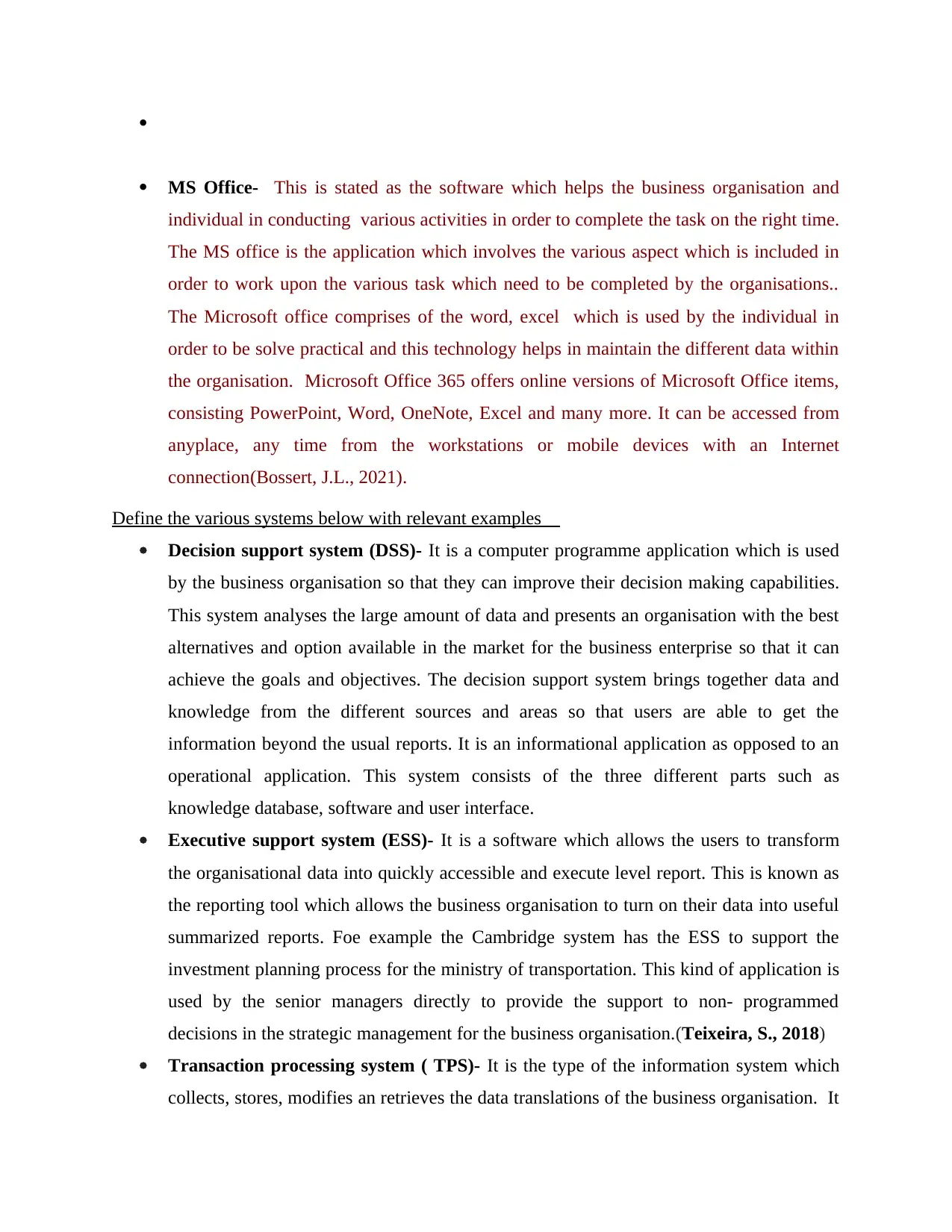
MS Office- This is stated as the software which helps the business organisation and
individual in conducting various activities in order to complete the task on the right time.
The MS office is the application which involves the various aspect which is included in
order to work upon the various task which need to be completed by the organisations..
The Microsoft office comprises of the word, excel which is used by the individual in
order to be solve practical and this technology helps in maintain the different data within
the organisation. Microsoft Office 365 offers online versions of Microsoft Office items,
consisting PowerPoint, Word, OneNote, Excel and many more. It can be accessed from
anyplace, any time from the workstations or mobile devices with an Internet
connection(Bossert, J.L., 2021).
Define the various systems below with relevant examples
Decision support system (DSS)- It is a computer programme application which is used
by the business organisation so that they can improve their decision making capabilities.
This system analyses the large amount of data and presents an organisation with the best
alternatives and option available in the market for the business enterprise so that it can
achieve the goals and objectives. The decision support system brings together data and
knowledge from the different sources and areas so that users are able to get the
information beyond the usual reports. It is an informational application as opposed to an
operational application. This system consists of the three different parts such as
knowledge database, software and user interface.
Executive support system (ESS)- It is a software which allows the users to transform
the organisational data into quickly accessible and execute level report. This is known as
the reporting tool which allows the business organisation to turn on their data into useful
summarized reports. Foe example the Cambridge system has the ESS to support the
investment planning process for the ministry of transportation. This kind of application is
used by the senior managers directly to provide the support to non- programmed
decisions in the strategic management for the business organisation.(Teixeira, S., 2018)
Transaction processing system ( TPS)- It is the type of the information system which
collects, stores, modifies an retrieves the data translations of the business organisation. It
MS Office- This is stated as the software which helps the business organisation and
individual in conducting various activities in order to complete the task on the right time.
The MS office is the application which involves the various aspect which is included in
order to work upon the various task which need to be completed by the organisations..
The Microsoft office comprises of the word, excel which is used by the individual in
order to be solve practical and this technology helps in maintain the different data within
the organisation. Microsoft Office 365 offers online versions of Microsoft Office items,
consisting PowerPoint, Word, OneNote, Excel and many more. It can be accessed from
anyplace, any time from the workstations or mobile devices with an Internet
connection(Bossert, J.L., 2021).
Define the various systems below with relevant examples
Decision support system (DSS)- It is a computer programme application which is used
by the business organisation so that they can improve their decision making capabilities.
This system analyses the large amount of data and presents an organisation with the best
alternatives and option available in the market for the business enterprise so that it can
achieve the goals and objectives. The decision support system brings together data and
knowledge from the different sources and areas so that users are able to get the
information beyond the usual reports. It is an informational application as opposed to an
operational application. This system consists of the three different parts such as
knowledge database, software and user interface.
Executive support system (ESS)- It is a software which allows the users to transform
the organisational data into quickly accessible and execute level report. This is known as
the reporting tool which allows the business organisation to turn on their data into useful
summarized reports. Foe example the Cambridge system has the ESS to support the
investment planning process for the ministry of transportation. This kind of application is
used by the senior managers directly to provide the support to non- programmed
decisions in the strategic management for the business organisation.(Teixeira, S., 2018)
Transaction processing system ( TPS)- It is the type of the information system which
collects, stores, modifies an retrieves the data translations of the business organisation. It
Paraphrase This Document
Need a fresh take? Get an instant paraphrase of this document with our AI Paraphraser
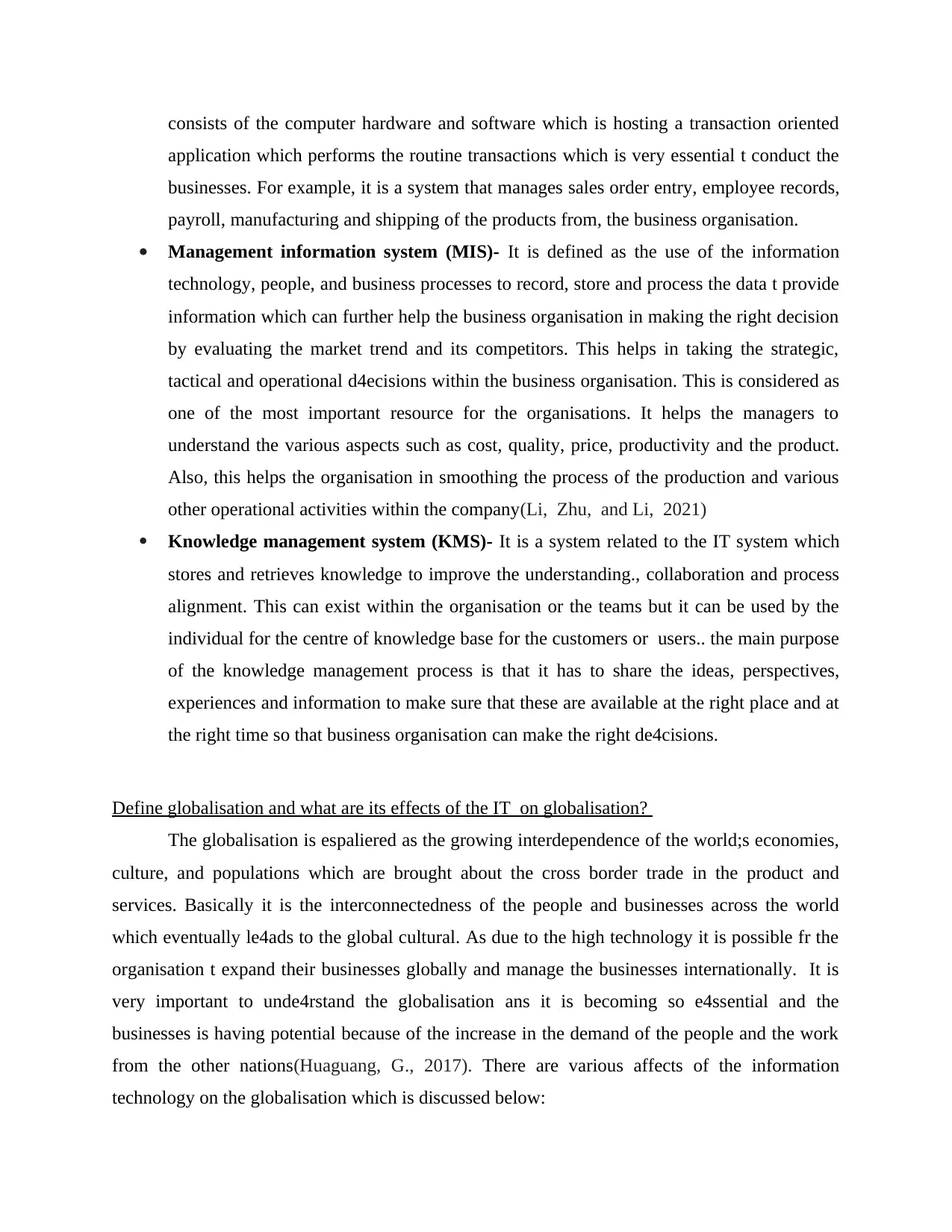
consists of the computer hardware and software which is hosting a transaction oriented
application which performs the routine transactions which is very essential t conduct the
businesses. For example, it is a system that manages sales order entry, employee records,
payroll, manufacturing and shipping of the products from, the business organisation.
Management information system (MIS)- It is defined as the use of the information
technology, people, and business processes to record, store and process the data t provide
information which can further help the business organisation in making the right decision
by evaluating the market trend and its competitors. This helps in taking the strategic,
tactical and operational d4ecisions within the business organisation. This is considered as
one of the most important resource for the organisations. It helps the managers to
understand the various aspects such as cost, quality, price, productivity and the product.
Also, this helps the organisation in smoothing the process of the production and various
other operational activities within the company(Li, Zhu, and Li, 2021)
Knowledge management system (KMS)- It is a system related to the IT system which
stores and retrieves knowledge to improve the understanding., collaboration and process
alignment. This can exist within the organisation or the teams but it can be used by the
individual for the centre of knowledge base for the customers or users.. the main purpose
of the knowledge management process is that it has to share the ideas, perspectives,
experiences and information to make sure that these are available at the right place and at
the right time so that business organisation can make the right de4cisions.
Define globalisation and what are its effects of the IT on globalisation?
The globalisation is espaliered as the growing interdependence of the world;s economies,
culture, and populations which are brought about the cross border trade in the product and
services. Basically it is the interconnectedness of the people and businesses across the world
which eventually le4ads to the global cultural. As due to the high technology it is possible fr the
organisation t expand their businesses globally and manage the businesses internationally. It is
very important to unde4rstand the globalisation ans it is becoming so e4ssential and the
businesses is having potential because of the increase in the demand of the people and the work
from the other nations(Huaguang, G., 2017). There are various affects of the information
technology on the globalisation which is discussed below:
application which performs the routine transactions which is very essential t conduct the
businesses. For example, it is a system that manages sales order entry, employee records,
payroll, manufacturing and shipping of the products from, the business organisation.
Management information system (MIS)- It is defined as the use of the information
technology, people, and business processes to record, store and process the data t provide
information which can further help the business organisation in making the right decision
by evaluating the market trend and its competitors. This helps in taking the strategic,
tactical and operational d4ecisions within the business organisation. This is considered as
one of the most important resource for the organisations. It helps the managers to
understand the various aspects such as cost, quality, price, productivity and the product.
Also, this helps the organisation in smoothing the process of the production and various
other operational activities within the company(Li, Zhu, and Li, 2021)
Knowledge management system (KMS)- It is a system related to the IT system which
stores and retrieves knowledge to improve the understanding., collaboration and process
alignment. This can exist within the organisation or the teams but it can be used by the
individual for the centre of knowledge base for the customers or users.. the main purpose
of the knowledge management process is that it has to share the ideas, perspectives,
experiences and information to make sure that these are available at the right place and at
the right time so that business organisation can make the right de4cisions.
Define globalisation and what are its effects of the IT on globalisation?
The globalisation is espaliered as the growing interdependence of the world;s economies,
culture, and populations which are brought about the cross border trade in the product and
services. Basically it is the interconnectedness of the people and businesses across the world
which eventually le4ads to the global cultural. As due to the high technology it is possible fr the
organisation t expand their businesses globally and manage the businesses internationally. It is
very important to unde4rstand the globalisation ans it is becoming so e4ssential and the
businesses is having potential because of the increase in the demand of the people and the work
from the other nations(Huaguang, G., 2017). There are various affects of the information
technology on the globalisation which is discussed below:
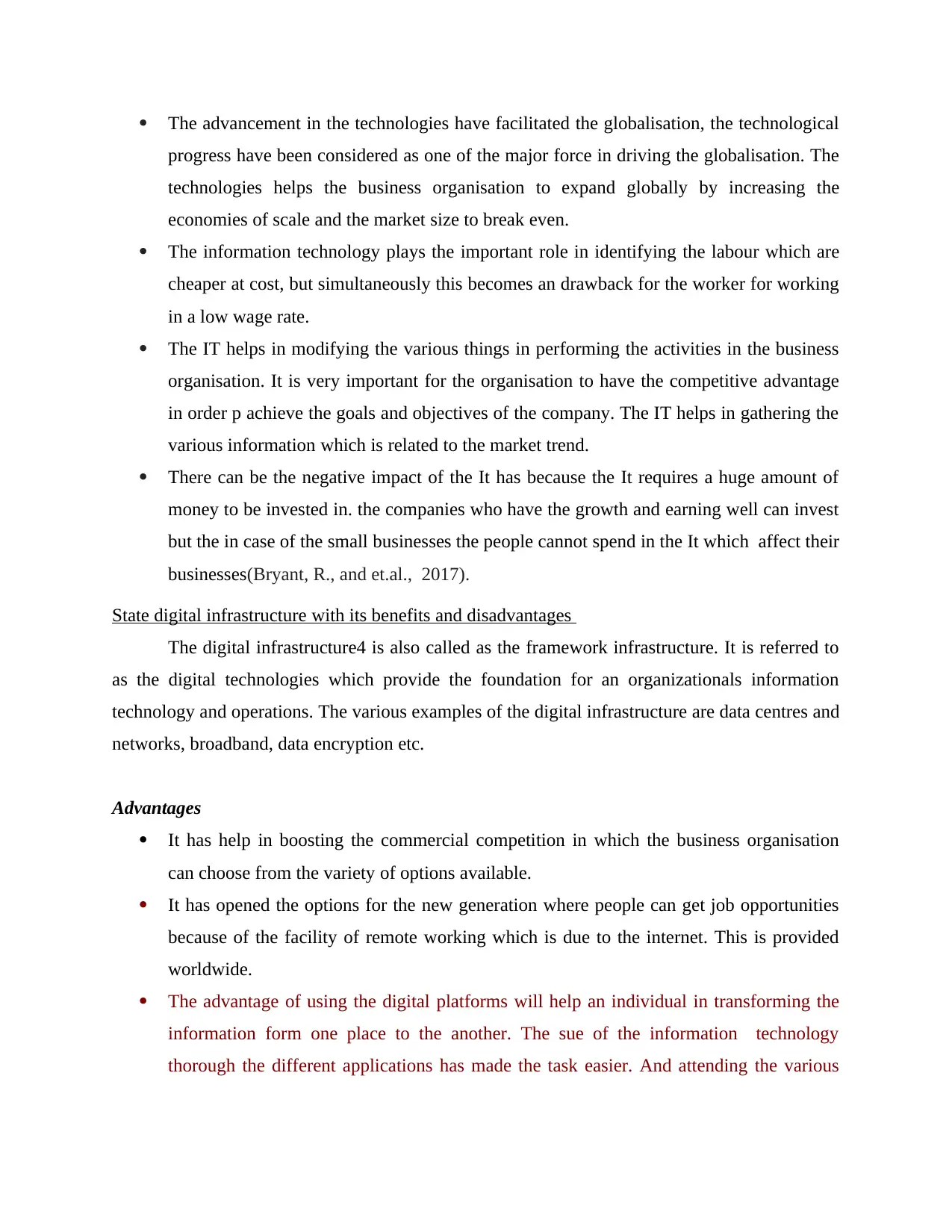
The advancement in the technologies have facilitated the globalisation, the technological
progress have been considered as one of the major force in driving the globalisation. The
technologies helps the business organisation to expand globally by increasing the
economies of scale and the market size to break even.
The information technology plays the important role in identifying the labour which are
cheaper at cost, but simultaneously this becomes an drawback for the worker for working
in a low wage rate.
The IT helps in modifying the various things in performing the activities in the business
organisation. It is very important for the organisation to have the competitive advantage
in order p achieve the goals and objectives of the company. The IT helps in gathering the
various information which is related to the market trend.
There can be the negative impact of the It has because the It requires a huge amount of
money to be invested in. the companies who have the growth and earning well can invest
but the in case of the small businesses the people cannot spend in the It which affect their
businesses(Bryant, R., and et.al., 2017).
State digital infrastructure with its benefits and disadvantages
The digital infrastructure4 is also called as the framework infrastructure. It is referred to
as the digital technologies which provide the foundation for an organizationals information
technology and operations. The various examples of the digital infrastructure are data centres and
networks, broadband, data encryption etc.
Advantages
It has help in boosting the commercial competition in which the business organisation
can choose from the variety of options available.
It has opened the options for the new generation where people can get job opportunities
because of the facility of remote working which is due to the internet. This is provided
worldwide.
The advantage of using the digital platforms will help an individual in transforming the
information form one place to the another. The sue of the information technology
thorough the different applications has made the task easier. And attending the various
progress have been considered as one of the major force in driving the globalisation. The
technologies helps the business organisation to expand globally by increasing the
economies of scale and the market size to break even.
The information technology plays the important role in identifying the labour which are
cheaper at cost, but simultaneously this becomes an drawback for the worker for working
in a low wage rate.
The IT helps in modifying the various things in performing the activities in the business
organisation. It is very important for the organisation to have the competitive advantage
in order p achieve the goals and objectives of the company. The IT helps in gathering the
various information which is related to the market trend.
There can be the negative impact of the It has because the It requires a huge amount of
money to be invested in. the companies who have the growth and earning well can invest
but the in case of the small businesses the people cannot spend in the It which affect their
businesses(Bryant, R., and et.al., 2017).
State digital infrastructure with its benefits and disadvantages
The digital infrastructure4 is also called as the framework infrastructure. It is referred to
as the digital technologies which provide the foundation for an organizationals information
technology and operations. The various examples of the digital infrastructure are data centres and
networks, broadband, data encryption etc.
Advantages
It has help in boosting the commercial competition in which the business organisation
can choose from the variety of options available.
It has opened the options for the new generation where people can get job opportunities
because of the facility of remote working which is due to the internet. This is provided
worldwide.
The advantage of using the digital platforms will help an individual in transforming the
information form one place to the another. The sue of the information technology
thorough the different applications has made the task easier. And attending the various
⊘ This is a preview!⊘
Do you want full access?
Subscribe today to unlock all pages.

Trusted by 1+ million students worldwide
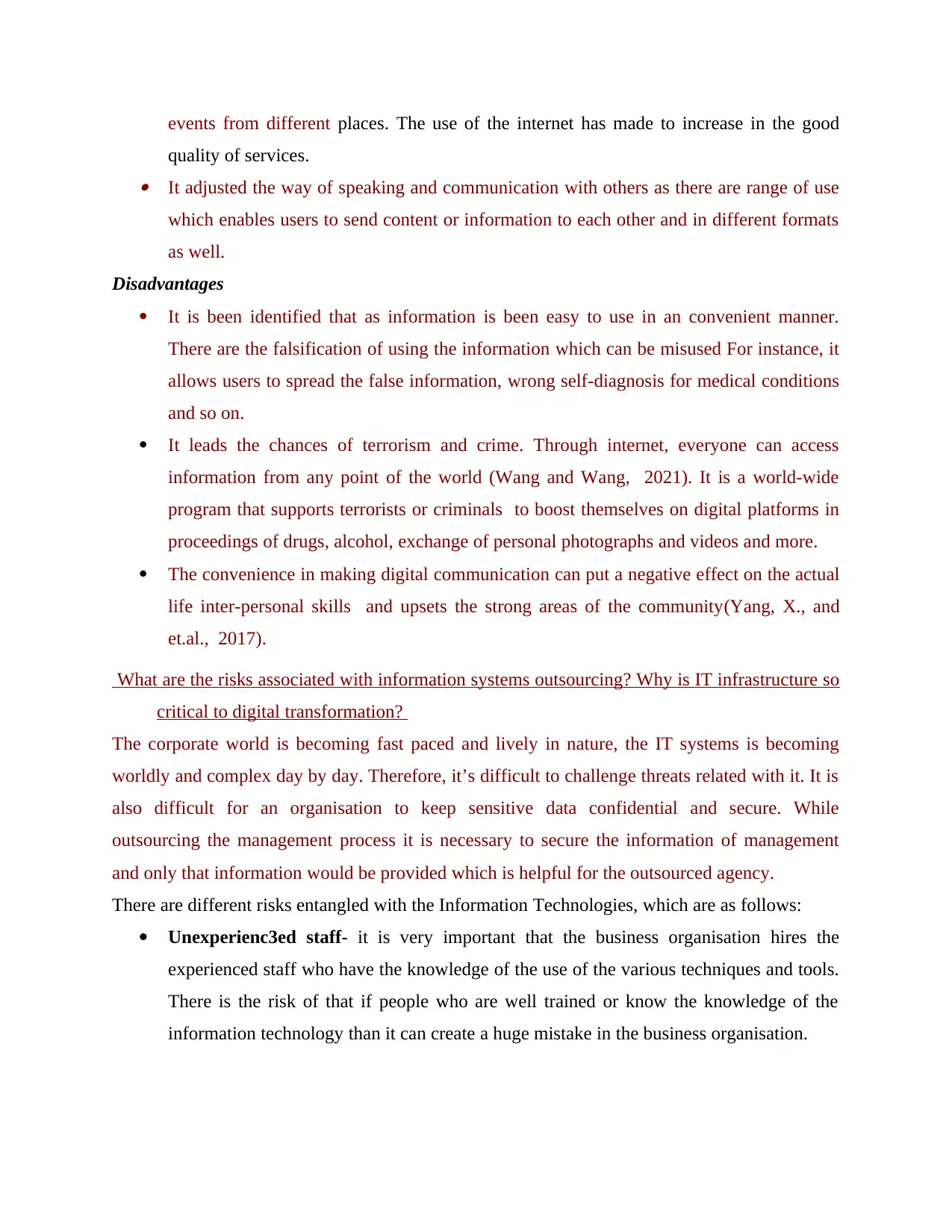
events from different places. The use of the internet has made to increase in the good
quality of services. It adjusted the way of speaking and communication with others as there are range of use
which enables users to send content or information to each other and in different formats
as well.
Disadvantages
It is been identified that as information is been easy to use in an convenient manner.
There are the falsification of using the information which can be misused For instance, it
allows users to spread the false information, wrong self-diagnosis for medical conditions
and so on.
It leads the chances of terrorism and crime. Through internet, everyone can access
information from any point of the world (Wang and Wang, 2021). It is a world-wide
program that supports terrorists or criminals to boost themselves on digital platforms in
proceedings of drugs, alcohol, exchange of personal photographs and videos and more.
The convenience in making digital communication can put a negative effect on the actual
life inter-personal skills and upsets the strong areas of the community(Yang, X., and
et.al., 2017).
What are the risks associated with information systems outsourcing? Why is IT infrastructure so
critical to digital transformation?
The corporate world is becoming fast paced and lively in nature, the IT systems is becoming
worldly and complex day by day. Therefore, it’s difficult to challenge threats related with it. It is
also difficult for an organisation to keep sensitive data confidential and secure. While
outsourcing the management process it is necessary to secure the information of management
and only that information would be provided which is helpful for the outsourced agency.
There are different risks entangled with the Information Technologies, which are as follows:
Unexperienc3ed staff- it is very important that the business organisation hires the
experienced staff who have the knowledge of the use of the various techniques and tools.
There is the risk of that if people who are well trained or know the knowledge of the
information technology than it can create a huge mistake in the business organisation.
quality of services. It adjusted the way of speaking and communication with others as there are range of use
which enables users to send content or information to each other and in different formats
as well.
Disadvantages
It is been identified that as information is been easy to use in an convenient manner.
There are the falsification of using the information which can be misused For instance, it
allows users to spread the false information, wrong self-diagnosis for medical conditions
and so on.
It leads the chances of terrorism and crime. Through internet, everyone can access
information from any point of the world (Wang and Wang, 2021). It is a world-wide
program that supports terrorists or criminals to boost themselves on digital platforms in
proceedings of drugs, alcohol, exchange of personal photographs and videos and more.
The convenience in making digital communication can put a negative effect on the actual
life inter-personal skills and upsets the strong areas of the community(Yang, X., and
et.al., 2017).
What are the risks associated with information systems outsourcing? Why is IT infrastructure so
critical to digital transformation?
The corporate world is becoming fast paced and lively in nature, the IT systems is becoming
worldly and complex day by day. Therefore, it’s difficult to challenge threats related with it. It is
also difficult for an organisation to keep sensitive data confidential and secure. While
outsourcing the management process it is necessary to secure the information of management
and only that information would be provided which is helpful for the outsourced agency.
There are different risks entangled with the Information Technologies, which are as follows:
Unexperienc3ed staff- it is very important that the business organisation hires the
experienced staff who have the knowledge of the use of the various techniques and tools.
There is the risk of that if people who are well trained or know the knowledge of the
information technology than it can create a huge mistake in the business organisation.
Paraphrase This Document
Need a fresh take? Get an instant paraphrase of this document with our AI Paraphraser
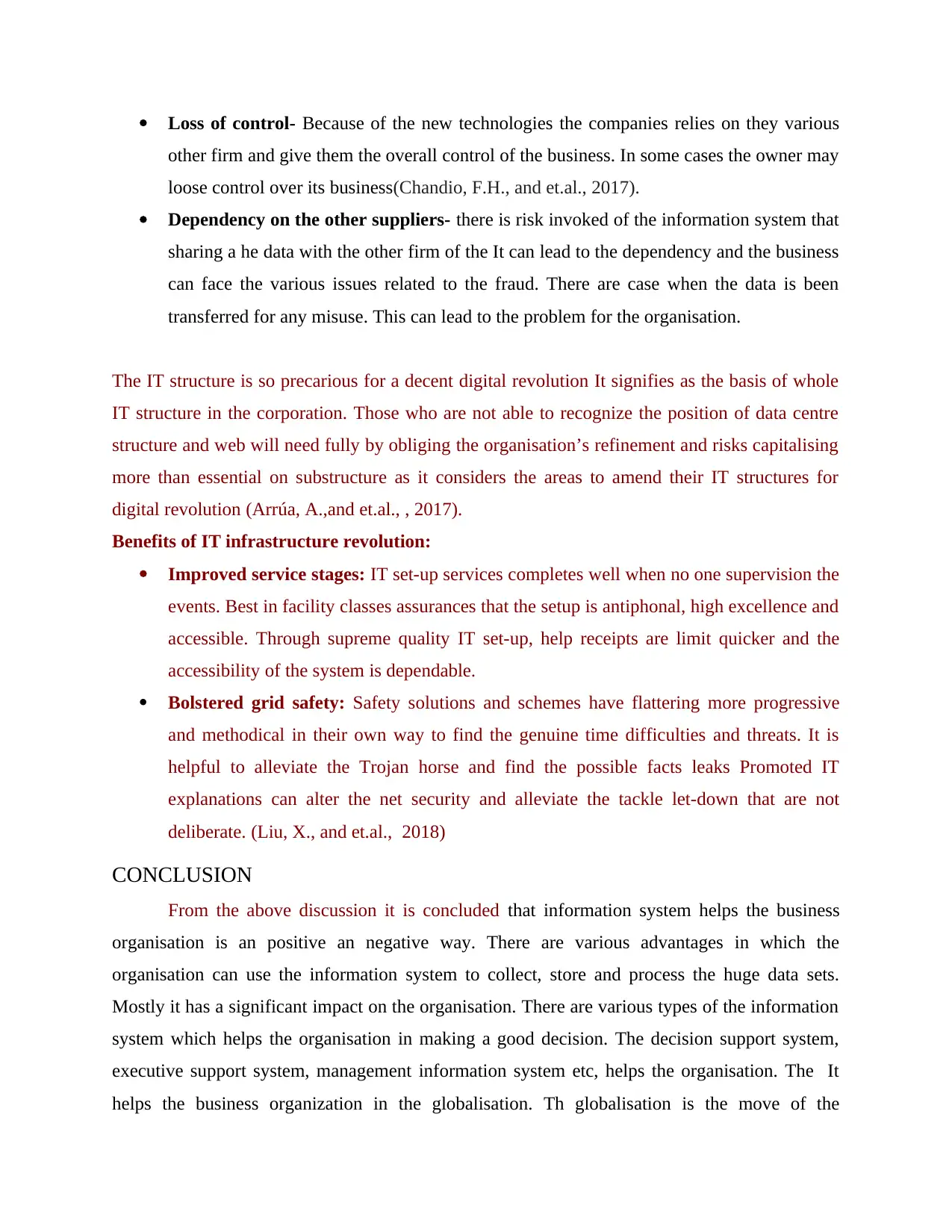
Loss of control- Because of the new technologies the companies relies on they various
other firm and give them the overall control of the business. In some cases the owner may
loose control over its business(Chandio, F.H., and et.al., 2017).
Dependency on the other suppliers- there is risk invoked of the information system that
sharing a he data with the other firm of the It can lead to the dependency and the business
can face the various issues related to the fraud. There are case when the data is been
transferred for any misuse. This can lead to the problem for the organisation.
The IT structure is so precarious for a decent digital revolution It signifies as the basis of whole
IT structure in the corporation. Those who are not able to recognize the position of data centre
structure and web will need fully by obliging the organisation’s refinement and risks capitalising
more than essential on substructure as it considers the areas to amend their IT structures for
digital revolution (Arrúa, A.,and et.al., , 2017).
Benefits of IT infrastructure revolution:
Improved service stages: IT set-up services completes well when no one supervision the
events. Best in facility classes assurances that the setup is antiphonal, high excellence and
accessible. Through supreme quality IT set-up, help receipts are limit quicker and the
accessibility of the system is dependable.
Bolstered grid safety: Safety solutions and schemes have flattering more progressive
and methodical in their own way to find the genuine time difficulties and threats. It is
helpful to alleviate the Trojan horse and find the possible facts leaks Promoted IT
explanations can alter the net security and alleviate the tackle let-down that are not
deliberate. (Liu, X., and et.al., 2018)
CONCLUSION
From the above discussion it is concluded that information system helps the business
organisation is an positive an negative way. There are various advantages in which the
organisation can use the information system to collect, store and process the huge data sets.
Mostly it has a significant impact on the organisation. There are various types of the information
system which helps the organisation in making a good decision. The decision support system,
executive support system, management information system etc, helps the organisation. The It
helps the business organization in the globalisation. Th globalisation is the move of the
other firm and give them the overall control of the business. In some cases the owner may
loose control over its business(Chandio, F.H., and et.al., 2017).
Dependency on the other suppliers- there is risk invoked of the information system that
sharing a he data with the other firm of the It can lead to the dependency and the business
can face the various issues related to the fraud. There are case when the data is been
transferred for any misuse. This can lead to the problem for the organisation.
The IT structure is so precarious for a decent digital revolution It signifies as the basis of whole
IT structure in the corporation. Those who are not able to recognize the position of data centre
structure and web will need fully by obliging the organisation’s refinement and risks capitalising
more than essential on substructure as it considers the areas to amend their IT structures for
digital revolution (Arrúa, A.,and et.al., , 2017).
Benefits of IT infrastructure revolution:
Improved service stages: IT set-up services completes well when no one supervision the
events. Best in facility classes assurances that the setup is antiphonal, high excellence and
accessible. Through supreme quality IT set-up, help receipts are limit quicker and the
accessibility of the system is dependable.
Bolstered grid safety: Safety solutions and schemes have flattering more progressive
and methodical in their own way to find the genuine time difficulties and threats. It is
helpful to alleviate the Trojan horse and find the possible facts leaks Promoted IT
explanations can alter the net security and alleviate the tackle let-down that are not
deliberate. (Liu, X., and et.al., 2018)
CONCLUSION
From the above discussion it is concluded that information system helps the business
organisation is an positive an negative way. There are various advantages in which the
organisation can use the information system to collect, store and process the huge data sets.
Mostly it has a significant impact on the organisation. There are various types of the information
system which helps the organisation in making a good decision. The decision support system,
executive support system, management information system etc, helps the organisation. The It
helps the business organization in the globalisation. Th globalisation is the move of the

businesses internationally. It is very important for the organisation t expand globally. The use of
the technologies has make the task easier top manage the business in the other nation as well. It
is been identified that as the business world is dynamic in nature and it is very important for the
organisation to be updates with the latest technology and this is becoming complex day by day.
There are various hurdles and risk involved while using the information technology which need
to be kept in mind by the business enterprises. For the success of the organisation they need to
make sure of the various processes of generating and spreading information system.
the technologies has make the task easier top manage the business in the other nation as well. It
is been identified that as the business world is dynamic in nature and it is very important for the
organisation to be updates with the latest technology and this is becoming complex day by day.
There are various hurdles and risk involved while using the information technology which need
to be kept in mind by the business enterprises. For the success of the organisation they need to
make sure of the various processes of generating and spreading information system.
⊘ This is a preview!⊘
Do you want full access?
Subscribe today to unlock all pages.

Trusted by 1+ million students worldwide
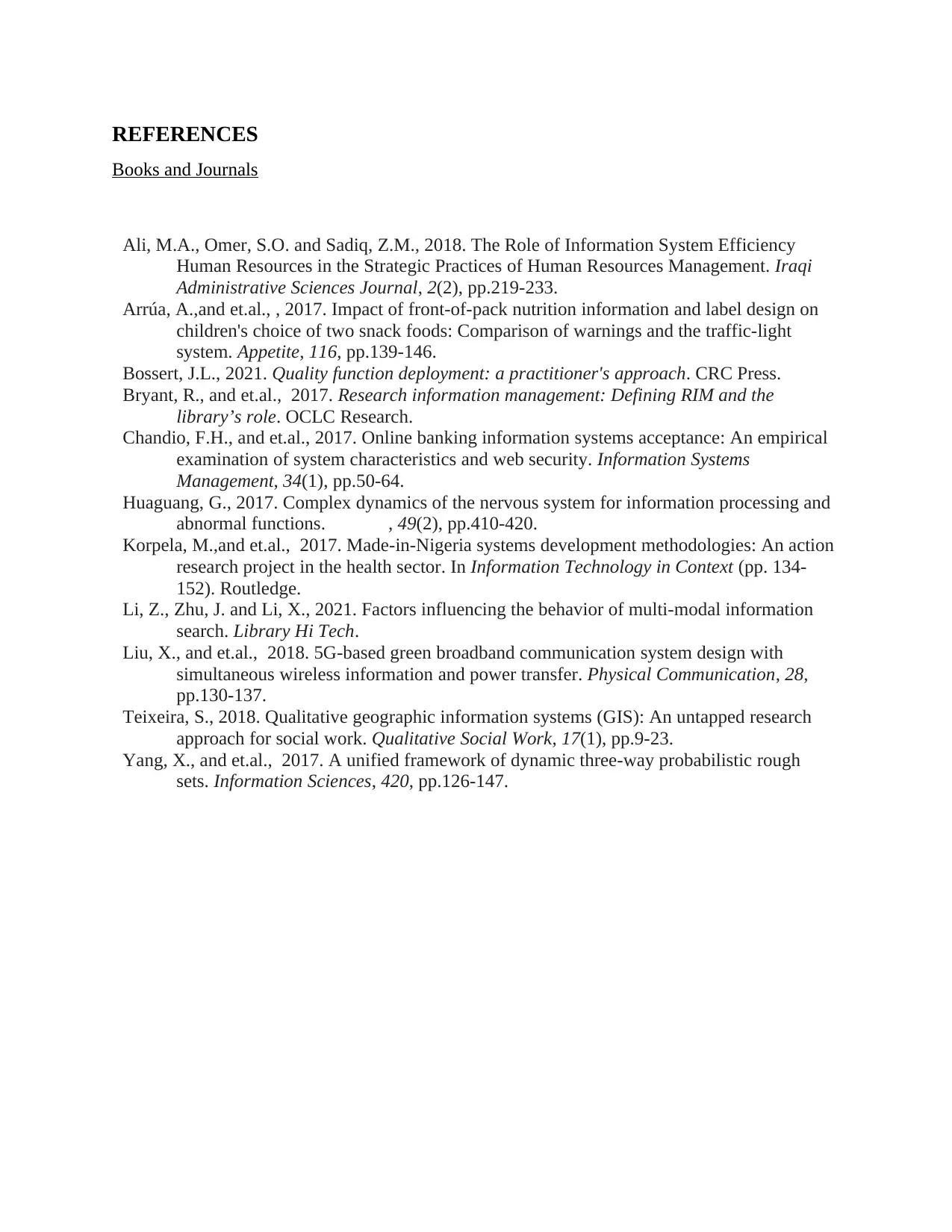
REFERENCES
Books and Journals
Ali, M.A., Omer, S.O. and Sadiq, Z.M., 2018. The Role of Information System Efficiency
Human Resources in the Strategic Practices of Human Resources Management. Iraqi
Administrative Sciences Journal, 2(2), pp.219-233.
Arrúa, A.,and et.al., , 2017. Impact of front-of-pack nutrition information and label design on
children's choice of two snack foods: Comparison of warnings and the traffic-light
system. Appetite, 116, pp.139-146.
Bossert, J.L., 2021. Quality function deployment: a practitioner's approach. CRC Press.
Bryant, R., and et.al., 2017. Research information management: Defining RIM and the
library’s role. OCLC Research.
Chandio, F.H., and et.al., 2017. Online banking information systems acceptance: An empirical
examination of system characteristics and web security. Information Systems
Management, 34(1), pp.50-64.
Huaguang, G., 2017. Complex dynamics of the nervous system for information processing and
abnormal functions. 力力力力, 49(2), pp.410-420.
Korpela, M.,and et.al., 2017. Made-in-Nigeria systems development methodologies: An action
research project in the health sector. In Information Technology in Context (pp. 134-
152). Routledge.
Li, Z., Zhu, J. and Li, X., 2021. Factors influencing the behavior of multi-modal information
search. Library Hi Tech.
Liu, X., and et.al., 2018. 5G-based green broadband communication system design with
simultaneous wireless information and power transfer. Physical Communication, 28,
pp.130-137.
Teixeira, S., 2018. Qualitative geographic information systems (GIS): An untapped research
approach for social work. Qualitative Social Work, 17(1), pp.9-23.
Yang, X., and et.al., 2017. A unified framework of dynamic three-way probabilistic rough
sets. Information Sciences, 420, pp.126-147.
Books and Journals
Ali, M.A., Omer, S.O. and Sadiq, Z.M., 2018. The Role of Information System Efficiency
Human Resources in the Strategic Practices of Human Resources Management. Iraqi
Administrative Sciences Journal, 2(2), pp.219-233.
Arrúa, A.,and et.al., , 2017. Impact of front-of-pack nutrition information and label design on
children's choice of two snack foods: Comparison of warnings and the traffic-light
system. Appetite, 116, pp.139-146.
Bossert, J.L., 2021. Quality function deployment: a practitioner's approach. CRC Press.
Bryant, R., and et.al., 2017. Research information management: Defining RIM and the
library’s role. OCLC Research.
Chandio, F.H., and et.al., 2017. Online banking information systems acceptance: An empirical
examination of system characteristics and web security. Information Systems
Management, 34(1), pp.50-64.
Huaguang, G., 2017. Complex dynamics of the nervous system for information processing and
abnormal functions. 力力力力, 49(2), pp.410-420.
Korpela, M.,and et.al., 2017. Made-in-Nigeria systems development methodologies: An action
research project in the health sector. In Information Technology in Context (pp. 134-
152). Routledge.
Li, Z., Zhu, J. and Li, X., 2021. Factors influencing the behavior of multi-modal information
search. Library Hi Tech.
Liu, X., and et.al., 2018. 5G-based green broadband communication system design with
simultaneous wireless information and power transfer. Physical Communication, 28,
pp.130-137.
Teixeira, S., 2018. Qualitative geographic information systems (GIS): An untapped research
approach for social work. Qualitative Social Work, 17(1), pp.9-23.
Yang, X., and et.al., 2017. A unified framework of dynamic three-way probabilistic rough
sets. Information Sciences, 420, pp.126-147.
1 out of 10